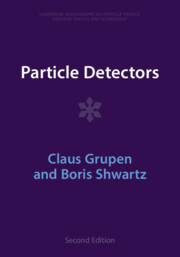
-
Select format
-
- Publisher:
- Cambridge University Press
- Publication date:
- 13 July 2023
- 27 July 2023
- ISBN:
- 9781009401531
- 9781009401494
- 9781009401517
- Creative Commons:
-
This content is Open Access and distributed under the terms of the Creative Commons Attribution licence CC-BY-NC-ND 4.0.
https://creativecommons.org/creativelicenses - Dimensions:
- (254 x 178 mm)
- Weight & Pages:
- 1.452kg, 676 Pages
- Dimensions:
- (254 x 178 mm)
- Weight & Pages:
- 1.25kg, 676 Pages
Open AccessYou have digital access to this book
Book description
Elementary particles can be identified through various techniques, depending on the purpose of the measurement and which relevant quantities, such as time, energy, and spatial coordinates, have to be measured. Detectors cover the measurement of energies spanning from the very low to the highest energies observed in cosmic rays. Describing the instrumentation for experiments in high energy physics and astroparticle physics, this edition describes track detectors, calorimeters, particle identification, neutrino detectors, momentum measurement, electronics, and data analysis. It also discusses applications of these detectors in other fields, such as nuclear medicine, radiation protection, and environmental science. Problem sets have been added to each chapter and additional instructive material has been provided, making this an excellent reference for graduate students and researchers in particle physics. First published in 2008, this title has been reissued as an Open Access publication on Cambridge Core.
Contents
Full book PDF-
Frontmatter
pp i-vi -
-
- You have access
- Open access
- Export citation
-
-
Contents
pp vii-xii -
-
- You have access
- Open access
- Export citation
-
-
Preface to the second edition
pp xiii-xv -
-
- You have access
- Open access
- Export citation
-
-
Preface to the first edition
pp xvi-xix -
-
- You have access
- Open access
- Export citation
-
-
Introduction
pp xx-xxiv -
-
- You have access
- Open access
- Export citation
-
-
1 - Interactions of particles and radiation with matter
pp 1-55 -
-
- You have access
- Open access
- Export citation
-
-
2 - Characteristic properties of detectors
pp 56-70 -
-
- You have access
- Open access
- Export citation
-
-
3 - Units of radiation measurements and radiation sources
pp 71-81 -
-
- You have access
- Open access
- Export citation
-
-
4 - Accelerators
pp 82-89 -
-
- You have access
- Open access
- Export citation
-
-
5 - Main physical phenomena used for particle detection and basic counter types
pp 90-159 -
-
- You have access
- Open access
- Export citation
-
-
6 - Historical track detectors
pp 160-185 -
-
- You have access
- Open access
- Export citation
-
-
7 - Track detectors
pp 186-229 -
-
- You have access
- Open access
- Export citation
-
-
8 - Calorimetry
pp 230-272 -
-
- You have access
- Open access
- Export citation
-
-
9 - Particle identification
pp 273-306 -
-
- You have access
- Open access
- Export citation
-
-
10 - Neutrino detectors
pp 307-326 -
-
- You have access
- Open access
- Export citation
-
-
11 - Momentum measurement and muon detection
pp 327-345 -
-
- You have access
- Open access
- Export citation
-
-
12 - Ageing and radiation effects
pp 346-359 -
-
- You have access
- Open access
- Export citation
-
-
13 - Example of a general-purpose detector: Belle
pp 360-389 -
-
- You have access
- Open access
- Export citation
-
-
14 - Electronics
pp 390-435 -
-
- You have access
- Open access
- Export citation
-
-
15 - Data analysis
pp 436-465 -
-
- You have access
- Open access
- Export citation
-
-
16 - Applications of particle detectors outside particle physics
pp 466-509 -
-
- You have access
- Open access
- Export citation
-
-
Résumé
pp 510-511 -
-
- You have access
- Open access
- Export citation
-
-
17 - Glossary
pp 512-532 -
-
- You have access
- Open access
- Export citation
-
-
18 - Solutions
pp 533-576 -
-
- You have access
- Open access
- Export citation
-
-
Appendix 1: - Table of fundamental physical constants
pp 577-579 -
-
- You have access
- Open access
- Export citation
-
-
Appendix 2: - Definition and conversion of physical units
pp 580-581 -
-
- You have access
- Open access
- Export citation
-
-
Appendix 3: - Properties of pure and composite materials
pp 582-583 -
-
- You have access
- Open access
- Export citation
-
-
Appendix 4: - Monte Carlo event generators
pp 584-590 -
-
- You have access
- Open access
- Export citation
-
-
Appendix 5: - Decay-level schemes
pp 591-598 -
-
- You have access
- Open access
- Export citation
-
-
Index
pp 599-652 -
-
- You have access
- Open access
- Export citation
-
Metrics
Altmetric attention score
Full text views
Full text views help Loading metrics...
Loading metrics...
* Views captured on Cambridge Core between #date#. This data will be updated every 24 hours.
Usage data cannot currently be displayed.
Accessibility standard: Unknown
Why this information is here
This section outlines the accessibility features of this content - including support for screen readers, full keyboard navigation and high-contrast display options. This may not be relevant for you.
Accessibility Information
Accessibility compliance for the PDF of this book is currently unknown and may be updated in the future.


